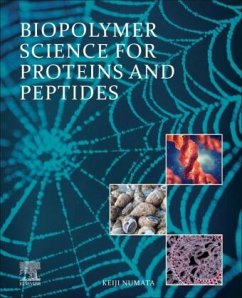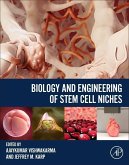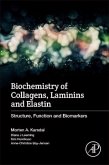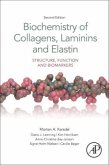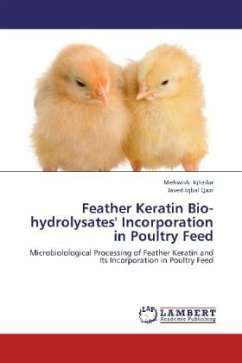Keiji Numata
Biopolymer Science for Proteins and Peptides
Keiji Numata
Biopolymer Science for Proteins and Peptides
- Broschiertes Buch
- Merkliste
- Auf die Merkliste
- Bewerten Bewerten
- Teilen
- Produkt teilen
- Produkterinnerung
- Produkterinnerung
Approx.296 pages
Andere Kunden interessierten sich auch für
![Biology and Engineering of Stem Cell Niches Biology and Engineering of Stem Cell Niches]() Biology and Engineering of Stem Cell Niches136,99 €
Biology and Engineering of Stem Cell Niches136,99 €![Biochemistry of Collagens, Laminins and Elastin Biochemistry of Collagens, Laminins and Elastin]() Morten KarsdalBiochemistry of Collagens, Laminins and Elastin72,99 €
Morten KarsdalBiochemistry of Collagens, Laminins and Elastin72,99 €![Biochemistry of Collagens, Laminins and Elastin Biochemistry of Collagens, Laminins and Elastin]() Morten KarsdalBiochemistry of Collagens, Laminins and Elastin100,99 €
Morten KarsdalBiochemistry of Collagens, Laminins and Elastin100,99 €![Evolution of Extracellular Matrix Evolution of Extracellular Matrix]() Evolution of Extracellular Matrix113,99 €
Evolution of Extracellular Matrix113,99 €![The Extracellular Matrix: an Overview The Extracellular Matrix: an Overview]() The Extracellular Matrix: an Overview226,99 €
The Extracellular Matrix: an Overview226,99 €![The Extracellular Matrix: an Overview The Extracellular Matrix: an Overview]() The Extracellular Matrix: an Overview226,99 €
The Extracellular Matrix: an Overview226,99 €![Feather Keratin Bio-hydrolysates' Incorporation in Poultry Feed Feather Keratin Bio-hydrolysates' Incorporation in Poultry Feed]() Mehwish IqtedarFeather Keratin Bio-hydrolysates' Incorporation in Poultry Feed52,99 €
Mehwish IqtedarFeather Keratin Bio-hydrolysates' Incorporation in Poultry Feed52,99 €-
-
-
Produktdetails
- Produktdetails
- Verlag: Elsevier / Elsevier Science & Technology
- Artikelnr. des Verlages: C2019-0-01392-1
- Englisch
- Abmessung: 228mm x 152mm x 229mm
- Gewicht: 500g
- ISBN-13: 9780128205556
- Artikelnr.: 60596925
- Herstellerkennzeichnung Die Herstellerinformationen sind derzeit nicht verfügbar.
- Verlag: Elsevier / Elsevier Science & Technology
- Artikelnr. des Verlages: C2019-0-01392-1
- Englisch
- Abmessung: 228mm x 152mm x 229mm
- Gewicht: 500g
- ISBN-13: 9780128205556
- Artikelnr.: 60596925
- Herstellerkennzeichnung Die Herstellerinformationen sind derzeit nicht verfügbar.
Keiji Numata is currently Full Professor in the Department of Material Chemistry, Kyoto University, and Team Leader at the Biomacromolecules Research Team, RIKEN Center for Sustainable Resource Science, Japan. He is also Research Director for JST-ERATO Numata Organellar Reaction Cluster Project and leads the Precision Polymer Degradation, Grant-in-Aid for Transformative Research Area, in Japan. He investigates biosynthesis and material design of structural proteins, polypeptides, and poly(amino acid). He previously worked as JSPS Postdoctoral Fellow for Research Abroad at Tufts University (Medford, MA, United States), where he studied
biosynthesis of silk-based polymers via bacterial pathways, as well as biomedical applications of silk-based polymers. Dr. Numata has received numerous awards for his work and is currently one of the associate editors of ACS Biomaterials Science and Engineering, and an editorial advisory board member for Biomacromolecules and ACS Polymers Au.
biosynthesis of silk-based polymers via bacterial pathways, as well as biomedical applications of silk-based polymers. Dr. Numata has received numerous awards for his work and is currently one of the associate editors of ACS Biomaterials Science and Engineering, and an editorial advisory board member for Biomacromolecules and ACS Polymers Au.
1. General introduction to polypeptide and protein materials2. Synthesis of polypeptide and protein materials3. Structure of polypeptide and protein materials4. Physical properties of polypeptide and protein materials5. Biological properties of polypeptide and protein materials with cells6. Stability of polypeptide and protein materials7. Structural proteins in nature8. Biopolymer materials and composites from polypeptide and proteins9. Applications as bulk material and future perspectives10. Experimental details
1. General introduction to polypeptide and protein materials2. Synthesis of polypeptide and protein materials3. Structure of polypeptide and protein materials4. Physical properties of polypeptide and protein materials5. Biological properties of polypeptide and protein materials with cells6. Stability of polypeptide and protein materials7. Structural proteins in nature8. Biopolymer materials and composites from polypeptide and proteins9. Applications as bulk material and future perspectives10. Experimental details

